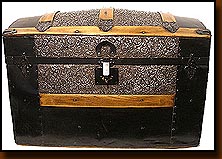Trunk History
Information
Make sure to also check out our
Trunk Photo Gallery Section,
and our Trunk Restoration section.
|
I have gathered information on Trunks over the last few years and this information is free and for research use only. |
|
Trunks date back to pre-medieval
times. They were made in many shapes and sizes and from various materials.
The earliest American made trunks were from the late 1600s. They
were made of various woods and covered with hides such as deer, horse or
cowhide. In the 1700s the hide covered trunks continued and became a
little more ornamented with handmade brass tacks, forged iron locks and
handles and leather trim. |
|
| This is a wonderful example of a Civil War era trunk that has been refinished. Due to the need for metal and leather in the Civil war era, these trunks were originally covered in paper and had very little tin used in their construction. However, the wood from over a hundred years old has a wonderful petina when refinished. Many of these Civil War Trunks were also banded with metal. |
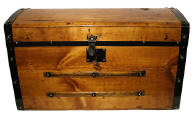 |
| In the late 1840s and 1850s leather covered trunks were popular with iron bands and large brass "studs" or "buttons". Some people referred to these as "gold rush trunks" , or "Stagecoach Trunks",with the large brass studs symbolizing large gold nuggets. |
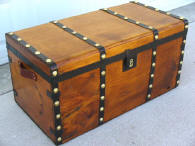 |
| Small square shaped "half trunks" were also made in the same style. These are similar to the European "Hat Box "Trunks which were very popular. They are also called "Ladies Trunks"due to their small size. |
|
||
|
|
|||
| In 1850, Jenny Lind, "the Swedish Nightingale" came to America and had a two year concert tour. She had trunks which were made in London which were soon copied by trunk makers all over America, which we now refer to as Jenny Lind trunks. They were usually leather covered, with several iron or Brass bands around the trunk, fastened with large brass studs, and they curved in at the center.They are often called Bread loaf trunks. These trunks were often very decorative with brass locks, fancy tooled leather and elaborate interiors with paper lining and trimmings. Models made with brass banding are referred to as "brass bound" Jenny Linds. They were so popular that the style continued until the 1870s in many sizes and varieties, including doll trunks. Some also refer to these trunks as "stagecoach" trunks as they were also used for stagecoach travel. |
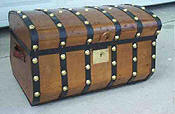 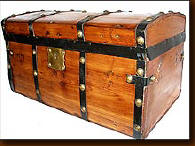 |
||
|
|
|||
| In the late 1870s a large fancy round top trunk became popular, because it was used by the wealthier people visiting the spas and racetrack at Saratoga Springs, New York. The Saratoga Trunk was a very large, domed top style with fancy trim, covered in either leather or metal. Early trunk catalogs and ads describe Saratoga trunks as a "large round top of the highest class". Round top trunks (also called humpback, camelback, monitor top, and barrel top) were made in a wide range of sizes and coverings. It is believed that the round tops were made for those who wanted to try to have their trunk packed on the top of baggage cars, so they would not be damaged. | |||
|
|
|||
|
|
|||
| From the very beginning of trunks, there were the Flat Top style. Among the most popular style trunks of the late 1800's and the early 1900's are the Flat top trunks. They are often covered in smooth metal, embossed, metal, or canvas. They then have wood slats and metal banding to strengthen them and for decorative design. These range from the basic trunks for utility to the more elaborate French and European designers like Louis Vuitton. |
 |
||
|
|
|||
|
European double lock Oak banded trunk Circa 1890-1910. These trunks were a newer generation of the older, more solid trunks previously made. The wood was thinner, and instead of wide wood slats, they used half round oak banding. These were in many sizes including a more modern looking suitcase size which was the beginning of the suitcase design. |
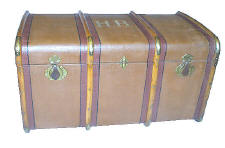 |
||
|
|
|||
| In the mid 1800's, a new style of all metal body trunks came about. These began primarily in England, and were made as an attempt to cut production costs of wood body covered trunks, while still producing a solid and sturdy trunk. These are not as common as many trunks, and have a unique style and beauty all their own |
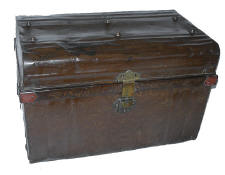 |
||
|
|
|||
|
French Trunk History General history: translated from French.
The oldest piece of furniture TRUNK: word which dates from the 9th
century, resulting from the high German, Malaha or malha and means satchel
the trunk is the oldest piece of furniture and one of the rare pieces of
furniture of the average age, at the time, it was used of chair, table,
trunk.... The trunks exist since the man travels. Their manufacture
however accelerated at the time of the development of the rail-bound
transport in the years 1870, you will thus find more trunks posterior at
this period. There are 2 kinds of "forms" the "bins" with flat lid, built
by the carpenters of small knocked: the huchiers the "sideboards" with
welch plug manufacture multiplied until in years 30-40 and it is after war
that the trunk more or less disappeared the last "malletiers" who exist
are: - Vuitton, Goyard, Ephtee (Bordeaux wine), the trunk Bernard and Old
england (which does not manufacture any more) LAYETIER PACKER the trade of
packer goes up already around 1521 François Pennies 1st, it is made
Mention of statutes governing this profession the word Layetier appears in
1582 and draws its origin from Thin layer which is a small trunk where the
jewels are preserved, documents of value... 19th, the 2 words layetier and
packer are associated to indicate the same profession the packer take the
dimension of all the objects to be transported (at the time, a diligence
that moves and all thus should be protected that is moved) and create to
measure a case. Contrary to the cabinet work traditional, the packer does
not use assembly but joins together with metal nails, possibly blades, the
small liteaux ones and sometimes a hinge and a lock. One chooses to pack
in fatty fabric or dry fabric. The fatty fabric is impregnated bituminous
substances, heated on straw and tended very strongly on the case, then the
dry fabric is extended. (That preserves at the same time moisture, bad
weather and tears) |
|||
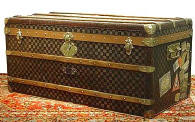 Louis Vuitton |
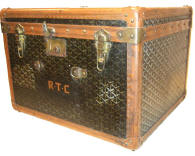 Goyard |
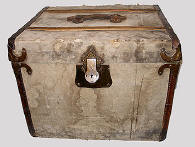 Moynat |
|
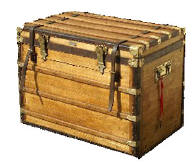 Alligre & Dullac |
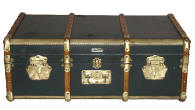 Lavolaille |
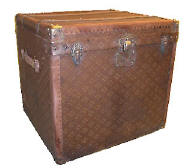 In the United States : Paris |
|
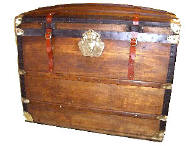 Stores of the Louvre |
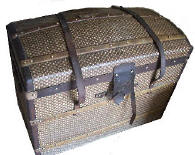 Georges (Paris) |
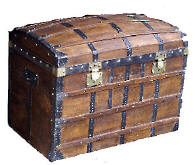 At the beginning in France (Paris) |
|
|
|
|||
| Canvas Covering on Trunks | |||
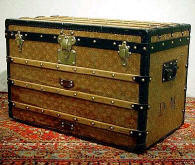 |
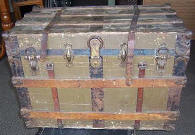 |
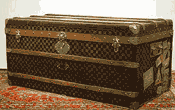 |
|
|
|
|||
|
Canvas was used on the outside of probably the majority of flat top trunks and occasionally on other styles (we have one Jenny Lind covered in canvas). The canvas varied in thickness, quality and color. Restore a lot of flat top trunks and you will get to know this canvas quite well, it can be proof there truly is a fine line between love and hate. Most flat top trunks that were covered in canvas end up having the canvas removed and the wood underneath refinished (we usually "refinish" a flat top as opposed to "restoring" it). Most of the time it's removed because it's too rotten to keep. Depending on many factors, the canvas can be very easy or extremely difficult to remove. The canvas served some very good purposes. The "box" of a trunk was built first, then the canvas was added to the outside. On top of this canvas went the staves, trim and hardware. The canvas was then coated with shellac which made the trunk practically waterproof. This combination of canvas and coating protected the outside of trunks from many things other than water. It acted as a sort of cushion when other trunks or objects were smashed against it. It kept out dust and added strength to the trunk by binding it. Most of all, it protected the beautiful pine or other wood underneath (most flat top background wood is pine, sometimes poplar or other wood). |
|||
Metal Covered
Trunks
|
|||
